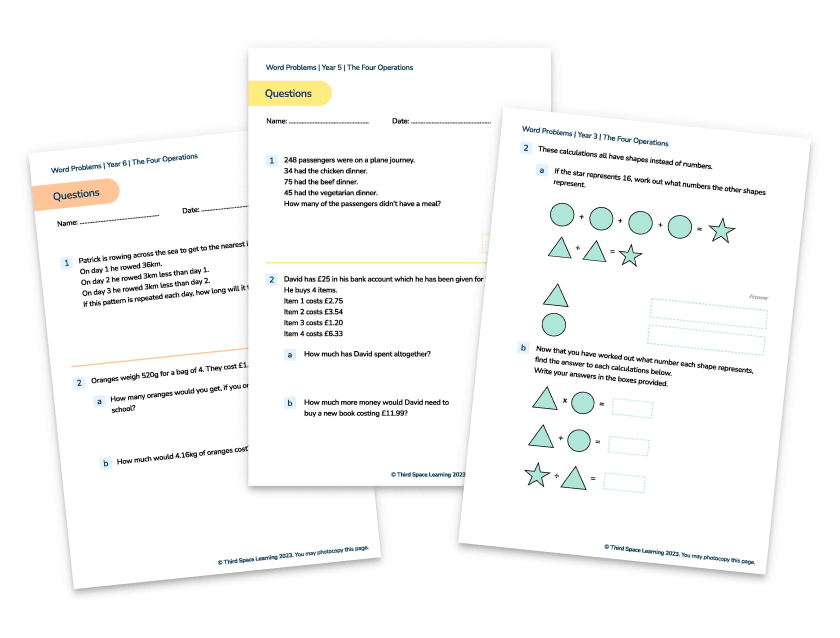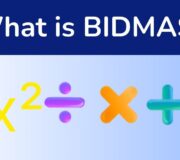How To Use Hinge Questions In Your Lessons To Move All Students Forward
Here we look at how you can make best use of hinge questions in your lessons to better gauge pupils’ responses, understand what you need to teach next, and just encourage pupils to think more carefully about a topic.
What are hinge questions?
Hinge questions are planned questions written prior to the lesson with a specific goal of assessing all pupils understanding and thinking at that point. The responses to the hinge question guide the teacher as to what the next stage of the lesson should be – whether to recap or move on.
The questions can take several forms, but should always aim to elicit a quick response from the whole class and should not interrupt the flow of the lesson. They should allow the teacher to assess the general understanding of a key concept within the class without having to ask each pupil individually for a detailed answer.
The Ultimate Guide to Maths Assessments
This guide offers a breakdown of primary and secondary math assessments, with proven strategies and free resources to use in the classroom.
Download Free Now!Should hinge questions be open ended questions or closed questions?
Educationalists talk a lot about effective questioning techniques, focusing particularly on the importance of open-ended questions. These are indeed an excellent way to spark discussion, assess student understanding and encourage deep thinking with a lesson.
However, when planning your ‘hinge questions’ or ‘hinge point questions,’ you are better off with closed questions. That’s because they are essentially mini diagnostic assessments for the whole class, so you need to know exactly what the possible answer options are that you’re expecting.
Why use hinge questions in the classroom?
Every teacher knows that lessons do not always follow the straight path you envisioned. You need to ensure that you are flexible and respond to the pupils’ needs within the lesson. This isn’t always easy, as there is a lot to fit into one year of teaching.
Hinge questions can be the formative assessment (assessment for learning) needed within a lesson to quickly check you haven’t lost anyone along the way. Hinge questions allow you to make an informed decision about the direction to take for the rest of the lesson. They give you information on the level of understanding of the class in general and highlighting any pupils who may need further support.
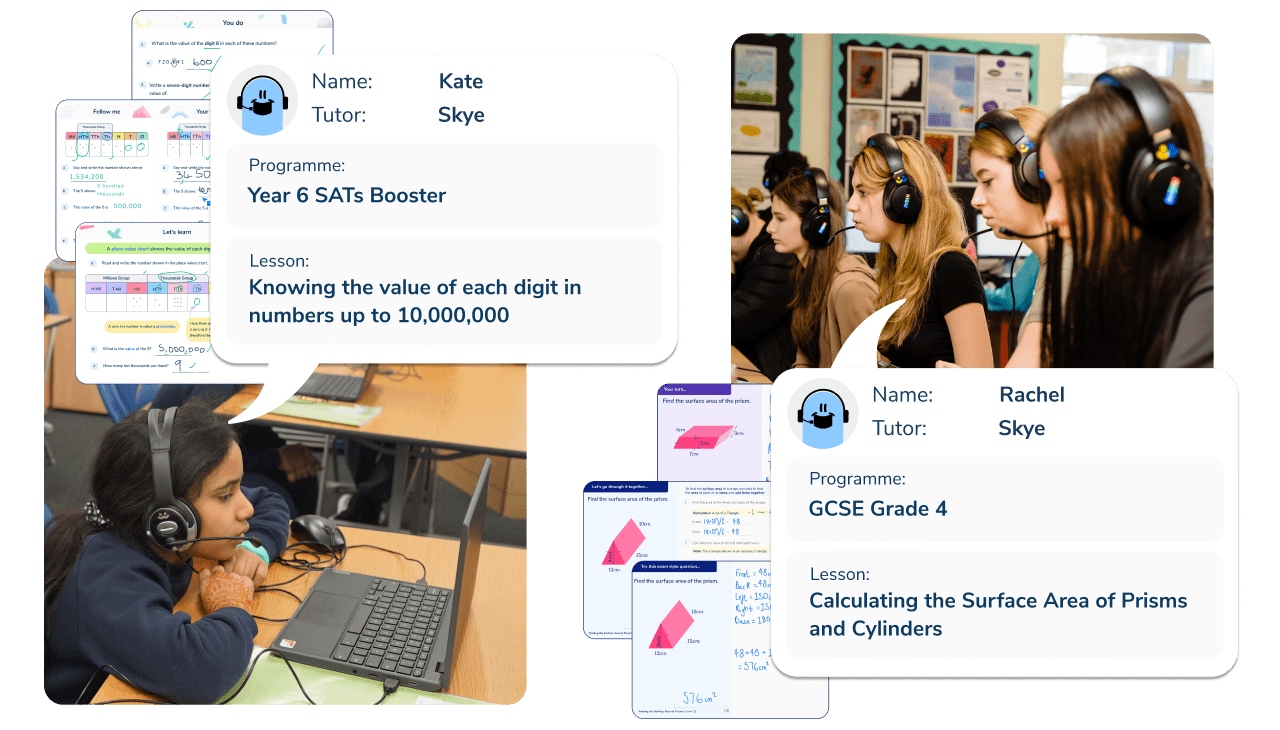
Meet Skye, the voice-based AI tutor making maths success possible for every student.
Built by teachers and maths experts, Skye uses the same pedagogy, curriculum and lesson structure as our traditional tutoring.
But, with more flexibility and a lower cost, schools can scale online maths tutoring to support every student who needs it.
Watch Skye in actionHow to create hinge questions
When you’re planning your lesson, there will be points at which, following teaching time you need to check for gaps or misconceptions. At this point, your hinge question comes in. Some people have created ‘rules’ for how long these hinge questions should take to answer (see below) but it’s all about what you need to elicit from the students.
And the best way to do this is with a very similar sort of multiple choice question that you might make for a diagnostic quiz. Each of the answers should expose a different misconception that a student can have at that stage in the lesson. By choosing these answer options carefully, you will be able to find out exactly who understood the concept and those who haven’t, what their misconceptions are.
How to use hinge questions
Hinge questions are an excellent assessment for learning strategy that can be used as and when necessary to ensure you, as a teacher, are responding appropriately to pupils’ needs.
Dylan Wiliam, professor and educationalist, has written and spoken about how lessons are not linear; starting at the beginning and traveling smoothly until the end, rather, “… you stop and you check to see whether the students are still with you and if they are, you do one thing and if they’re not, you do something else”.
The best way of doing this is “… at least once every 20 – 30 minutes, if you’re going to make sensible decisions about what to do next, you need to get a response from the whole class and we call these hinge questions”.
Quick questions must be posed to the entire class and the teacher needs to be able to “eyeball the whole class responses and make a decision about what that means in 30 seconds or less”.
He explains how deciding the overall understanding of the class by asking questions to 2 or 3 pupils doesn’t work, instead hinge questions asked to the whole class can be effective.
Example of a hinge question that clearly identifies a misconception
The best hinge questions will aim to address key misconceptions that could arise in the lesson. An example of this in mathematics is a hinge question that addresses multiplying decimal numbers by 10, 100 or 1,000.
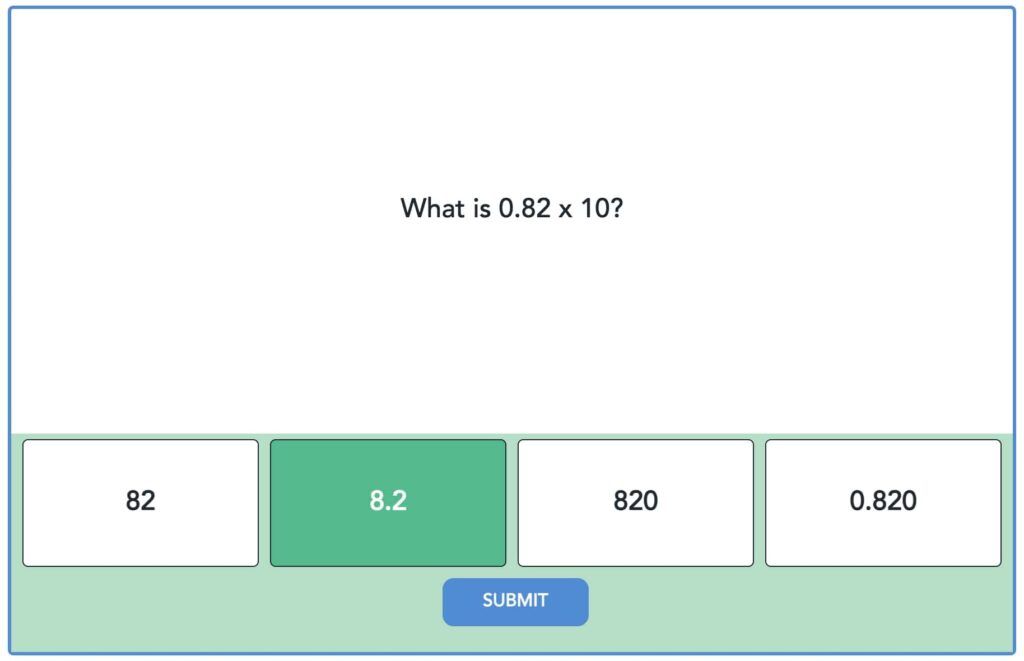
and dividing whole numbers and decimals by 10 and 100.
In this question, a pupil who believes that multiplying by 10 means ‘adding a zero’ will select the wrong answer of 0.820. This shows that the pupil does not understand the key concept of multiplying by 10.
Alternatively, a pupil who understands that the digits move to the left, showing the value of the digits increasing by a power of 10, may select 82 or 820. This shows an understanding of the process (x10 means moving digits to make the number 10 times the size), but also shows that they do not fully understand how to move the digits when multiplying by 10.
As all pupils answer individually but simultaneously as their peers, they cannot easily ‘hide’ their answer if it is incorrect. If you encourage a positive attitude of learning from mistakes in your classroom, they will understand that an incorrect answer is an opportunity for learning.
How to ask your hinge question
Hinge questions can take any form of question, as long as they allow a teacher to gain real-time responses from all your pupils at once, and quickly identify the general understanding of the class.
The question should give instant, usable feedback without too much need for discussion to identify the method used to answer the question. If the pupil can ascertain the correct answer from an incorrect method, the hinge question and answer options needs rethinking.
One of the easiest ways to pose a hinge question is in the form of a multiple choice question. By providing several possible options, the cognitive load is reduced. This also speeds up the process as the pupils have options to choose from.
How students should answer the hinge questions
There are lots of ways you can ask and elicit answers for your hinge questions. Some schools will have online tools like Socrative or Kahoot. For others, this is where the mini whiteboard comes into its own. Once you provide the choices, all the students have to do is write done a letter on their board and hold it up for you to review in a matter of minutes.
Be sure to communicate that this isn’t a test and getting it wrong is ok, so they shouldn’t change their answer once everyone has shown theirs.
Assessing hinge question responses
Set some form of ‘pass mark’ for the hinge question for yourself (not for the students). This is a way for you to know which direction to take for the rest of the lesson. If, for example, only 2 out of 30 pupils have the correct answer, consider reteaching the lesson in another way to help solidify all pupils’ understanding of the concept being covered.
If you have thought about the hinge question prior to the lesson, you will know how to pivot the lesson to better meet the needs of your class.
How to use hinged questions in tutoring
At Third Space Learning, we use hinge questions a lot, most notably in the form of skill check-in questions in our online one-to-one maths tutoring. The learners’ answer determines what happens next in the lesson and the level of support they will receive. AI tutor Skye also asks questions throughout the lesson to check understanding, encourage reasoning and provide hints to help the student get to the answer, plus diagnostic questions in our Ready-to-go lessons (RTG).
Next steps after your hinge question
This can all sound very daunting… Do you need to have multiple plans for after the hinge question?
- For if they get it right!
- For half understanding and half not understanding
- They all are lost!
As more experienced teachers will know, teaching requires a lot of thinking on your feet and this is just another tool that can be used to help you identify if and when you need to modify your lesson.
The good news is that hinge questions are not necessarily needed for every lesson. As with all teaching tools, they can be used if and when you feel they are necessary. It is all about the context.
The next step after using a hinge question doesn’t always need to be completely changing the direction of the whole lesson. It could mean working with a small group of pupils who didn’t quite understand to support them, or a quick partner discussion to discuss why the distractors are wrong. This can lead to some excellent discussions and peer-to-peer support.
Alternatively, you may decide to progress with your whole class teaching but the student responses to the hinge question may help to guide your differentiation approach and differentiation in teaching strategy.
Read more: Formative And Summative Assessment
Right place right time: when should you ask hinge questions?
Hinge questions are most effective when used during a lesson, but they are also useful at the start or end of the lesson. They are designed to make your students think about what they are learning right now and help you consider the direction of the lesson.
You might decide to use hinge questions only in the lessons where you are introducing new concepts or lessons where you know pupils might struggle. For example, in Year 3, pupils start to multiply 2-digit numbers by 1-digit numbers including with regrouping. A well-placed hinge question can identify pupils who do not know how to complete this before they move on to the trickier concept of regrouping with larger numbers.
How can you use hinge questions alongside other teaching tools?
Hinge questions do not need to be taxing to carry out.
- Pupils can use mini whiteboards to write or show their answers.
- With multiple choice questions, pupils could use ABCD cards. I find these work best if the cards are colour coded (e.g. a is blue, b is red etc) so that you can quickly see the colour and therefore letter the pupil has selected.
- In a similar way, digit cards can be used to show the answer.
The more familiar pupils are with the format and expectations of hinge questions, the easier the process will become. Using hinge questions in conjunction with multiple choice diagnostic assessments can help reduce the anxiety around this type of assessments as they become normalised.
Introducing hinge questions to staff
Hinge questions may not be an intuitive tool for every teacher. If you want the whole school to adopt hinge questions, it may be beneficial to offer CPD during a staff meeting on hinge questions. If one teacher is particularly good at using hinge questions and responding to needs in the moment, you could ask them to share their experience to help others understand that it doesn’t have to be a daunting task to implement.
Hinge questions and STEM learning
Hinge questions are especially useful in STEM subjects like maths as questions generally have a right or wrong answer, unlike other subjects where there can be grey areas or opinion-based answers.
In maths, there are many misconceptions that pupils can develop over time. Fundamental maths misconceptions can make developing a deep understanding of mathematical concepts exceptionally difficult and therefore need to be addressed as early as possible.
Using well-designed hinge questions can help teachers to identify these misconceptions and address them quickly. If you want to address gaps in prior knowledge, rather than specific misunderstanding from a lesson, you might want to try a maths diagnostic test.
How we use hinge questions at Third Space Learning
At Third Space Learning, we have several ways that we use hinge questions.
Third Space Learning Resources
Our popular Ready-to-go lesson slides include a hinge question for every lesson. These are situated outside of the content of the lesson so that you can decide if you want to use the question.
Each question relates to the key concept covered by the learning objective, along with 3 distractor answers (with explanations) and one correct answer.
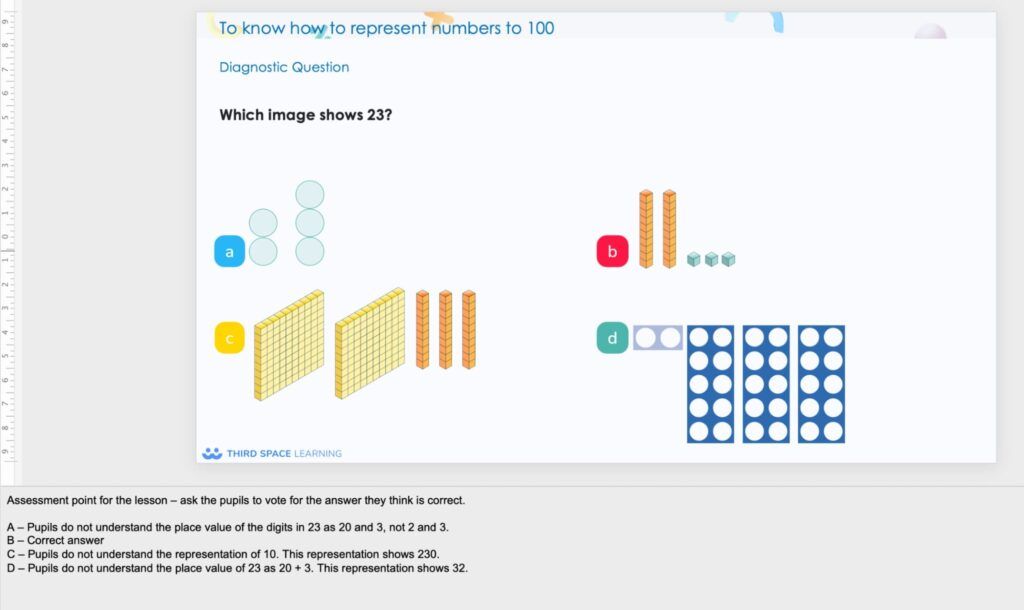
This hinge question shows that you can use images as well as numbers.
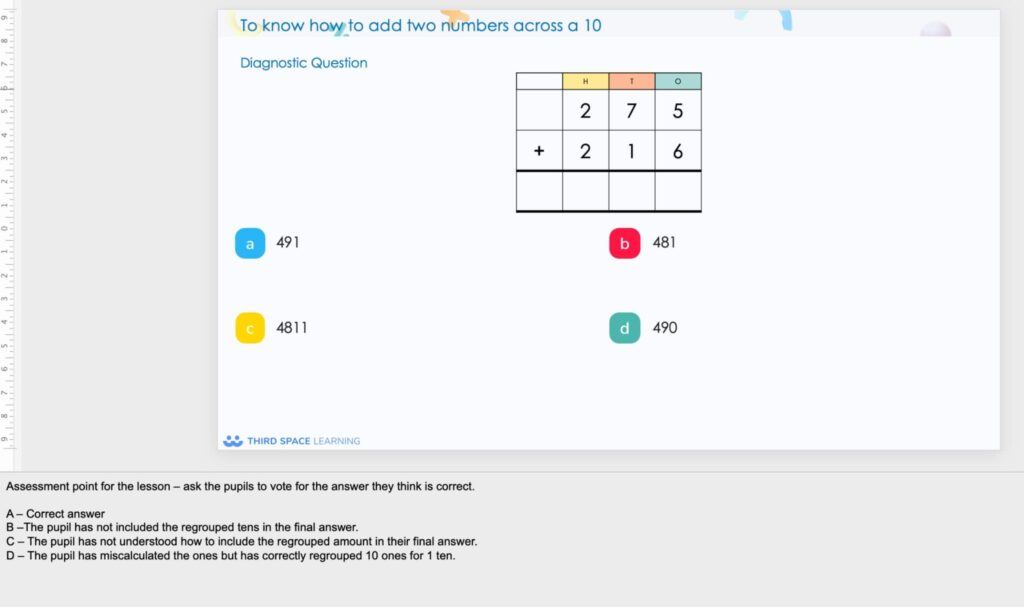
common misconception of regrouping is addressed here.
Take a look at our collection of primary, ready to go lesson slides.
Hinge questions in Third Space Learning online tutoring
Teachers choose the appropriate programme of lessons for each pupil targeting a particular topic area or, for secondary students, GCSE grade.
Every lesson begins with a short skill check-in question. Depending on how pupils answer this question determines the rest of the lesson.
If the pupil demonstrates they understand how to answer the question, Skye moves straight on to independent practice questions.
But if the student needs a little more support with the concept, Skye provides additional scaffolded support.
Hinge questions in diagnostic assessments
At the end of each lesson, pupils answer a skill check-out question. This assesses how well they have understood the learning objective and maths concepts.
If the pupil needs additional support, Skye provides structured hints to support them to be successful.
Data from these questions is made available to their teachers to allow them to us what the students have learnt in their AI tutoring session, and build on it in their normal maths lessons.
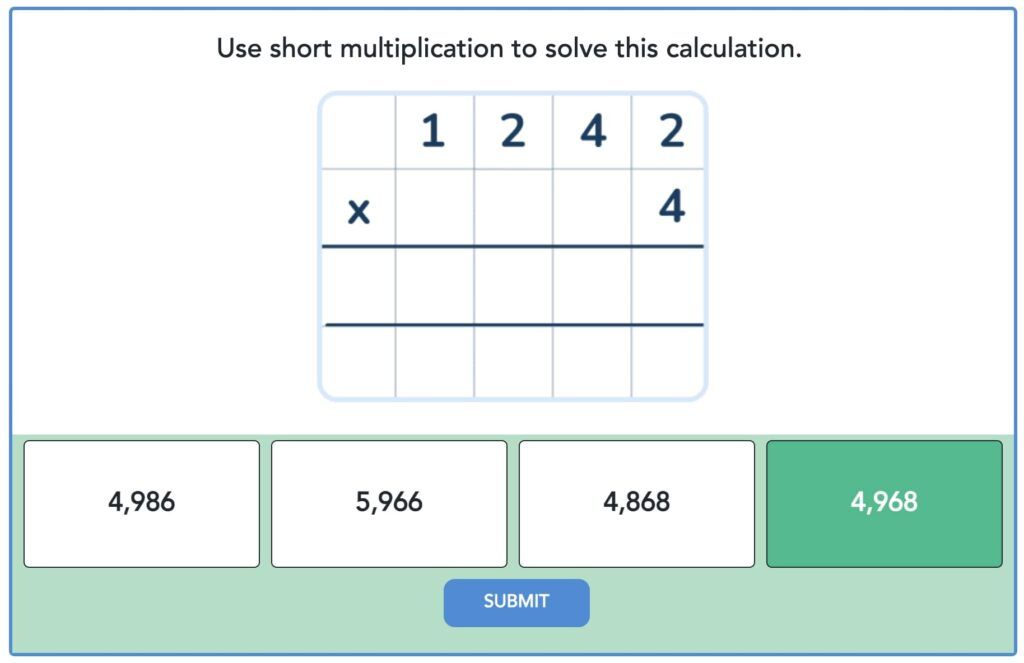
Tests for misconceptions around regrouping.
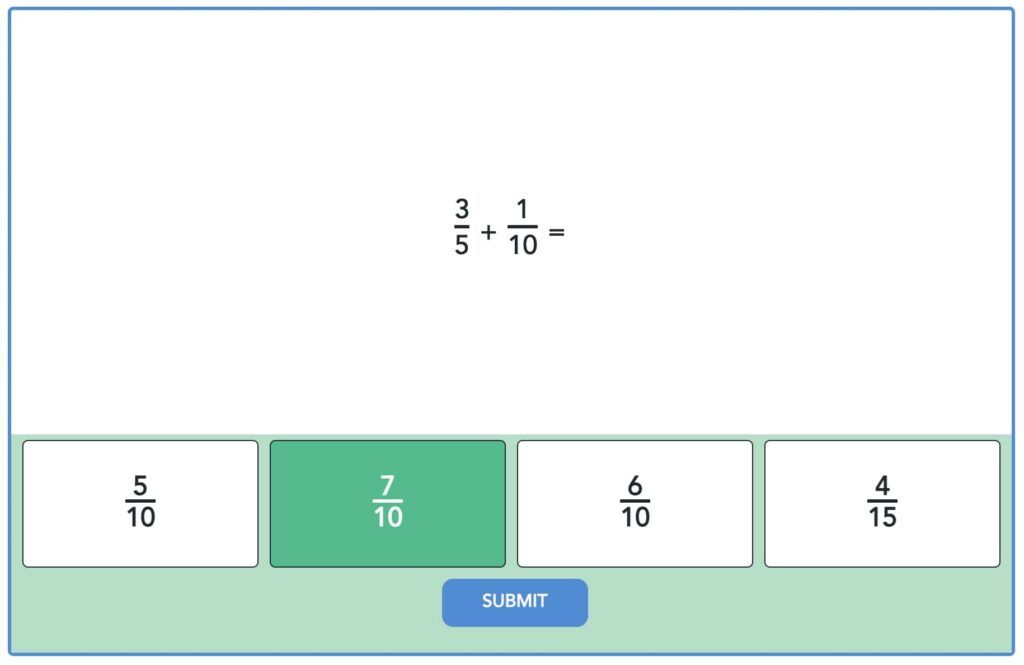
Hinge question examples
Year 1: Addition and subtraction within 10 lesson 13
Which number sentence is also in this fact family? 6 + 4 = 10
a) 8 + 2
b) 7 – 5
c) 4 + 6
d) 6 – 4
Year 2: Place value lesson 6
How do I write this number in words? 62
a) six-two
b) twenty-six
c) sixty-two
d) sixty-twenty
Year 3: Multiplication and division lesson 11
To find the answer to 4 x 4, which calculation could I complete?
a) 3 x 4 – 4
b) 5 x 4 – 4
c) 2 x 4 then half the answer
d) 5 x 4 + 4
Year 4: Addition and subtraction lesson 1
5,235 + 4 tens =
a) 9,235
b) 5,239
c) 5,635
d) 5,275
Year 5: Fractions A, lesson 9
Calculate 11/15 + 7/15
a) 18/30
b) 1 3/15
c) 4/15
d) 1 8/15
Year 6: Converting units lesson 2
Complete the conversion 14.5 = …cm
a) 145cm
b) 14,500cm
c) 0.0145cm
d) 1,450cm
A good hinge question should address the key concept of the lesson and only be able to be solved using the correct method.
Hinge questions are best used during the lesson to identify the progress of the pupils and identify the trajectory of the rest of the lesson.
Hinge questions provide excellent assessment for learning opportunities and allow the teacher to respond in real time to the needs of the pupils.
DO YOU HAVE STUDENTS WHO NEED MORE SUPPORT IN MATHS?
Skye – our AI maths tutor built by teachers – gives students personalised one-to-one lessons that address learning gaps and build confidence.
Since 2013 we’ve taught over 2 million hours of maths lessons to more than 170,000 students to help them become fluent, able mathematicians.
Explore our AI maths tutoring or find out about maths intervention programmes for your school.
